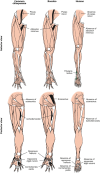Bonobo anatomy reveals stasis and mosaicism in chimpanzee evolution, and supports bonobos as the most appropriate extant model for the common ancestor of chimpanzees and humans
- PMID: 28377592
- PMCID: PMC5428693
- DOI: 10.1038/s41598-017-00548-3
Bonobo anatomy reveals stasis and mosaicism in chimpanzee evolution, and supports bonobos as the most appropriate extant model for the common ancestor of chimpanzees and humans
Abstract
Common chimps and bonobos are our closest living relatives but almost nothing is known about bonobo internal anatomy. We present the first phylogenetic analysis to include musculoskeletal data obtained from a recent dissection of bonobos. Notably, chimpanzees, and in particular bonobos, provide a remarkable case of evolutionary stasis for since the chimpanzee-human split c.8 Ma among >120 head-neck (HN) and forelimb (FL) muscles there were only four minor changes in the chimpanzee clade, and all were reversions to the ancestral condition. Moreover, since the common chimpanzee-bonobo split c.2 Ma there have been no changes in bonobos, so with respect to HN-FL musculature bonobos are the better model for the last common ancestor (LCA) of chimpanzees/bonobos and humans. Moreover, in the hindlimb there are only two muscle absence/presence differences between common chimpanzees and bonobos. Puzzlingly, there is an evolutionary mosaicism between each of these species and humans. We discuss these data in the context of available genomic information and debates on whether the common chimpanzee-bonobo divergence is linked to heterochrony.
Conflict of interest statement
The authors declare that they have no competing interests.
Figures




Similar articles
-
MHC class I diversity in chimpanzees and bonobos.Immunogenetics. 2017 Oct;69(10):661-676. doi: 10.1007/s00251-017-0990-x. Epub 2017 Jun 16. Immunogenetics. 2017. PMID: 28623392 Free PMC article.
-
Extensive nuclear DNA sequence diversity among chimpanzees.Science. 1999 Nov 5;286(5442):1159-62. doi: 10.1126/science.286.5442.1159. Science. 1999. PMID: 10550054
-
Limited MHC class I intron 2 repertoire variation in bonobos.Immunogenetics. 2017 Oct;69(10):677-688. doi: 10.1007/s00251-017-1010-x. Epub 2017 Jun 16. Immunogenetics. 2017. PMID: 28623393
-
On the tool use behavior of the bonobo-chimpanzee last common ancestor, and the origins of hominine stone tool use.Am J Primatol. 2014 Oct;76(10):910-8. doi: 10.1002/ajp.22284. Epub 2014 Apr 7. Am J Primatol. 2014. PMID: 24710771 Review.
-
The expression of empathy in human's closest relatives, bonobos and chimpanzees: current and future directions.Biol Rev Camb Philos Soc. 2024 Aug;99(4):1556-1575. doi: 10.1111/brv.13080. Epub 2024 Apr 10. Biol Rev Camb Philos Soc. 2024. PMID: 38597291 Review.
Cited by
-
Segmental morphometrics of bonobos (Pan paniscus): are they really different from chimpanzees (Pan troglodytes)?J Anat. 2018 Dec;233(6):843-853. doi: 10.1111/joa.12894. Epub 2018 Oct 7. J Anat. 2018. PMID: 30294787 Free PMC article.
-
Towards the restoration of ancient hominid craniofacial anatomy: Chimpanzee morphology reveals covariation between craniometrics and facial soft tissue thickness.PLoS One. 2021 Jun 4;16(6):e0245760. doi: 10.1371/journal.pone.0245760. eCollection 2021. PLoS One. 2021. PMID: 34086683 Free PMC article.
-
Ape femoral-humeral rigidities and arboreal locomotion.Am J Biol Anthropol. 2022 Dec;179(4):624-639. doi: 10.1002/ajpa.24632. Epub 2022 Oct 31. Am J Biol Anthropol. 2022. PMID: 36790629 Free PMC article.
-
Stress distribution in the bonobo (Pan paniscus) trapeziometacarpal joint during grasping.PeerJ. 2021 Oct 1;9:e12068. doi: 10.7717/peerj.12068. eCollection 2021. PeerJ. 2021. PMID: 34703659 Free PMC article.
-
Insights into the musculature of the bonobo hand.J Anat. 2018 Jun 25;233(3):328-40. doi: 10.1111/joa.12841. Online ahead of print. J Anat. 2018. PMID: 29938781 Free PMC article.
References
-
- Chimpanzee Sequencing Analysis Consortium. Initial sequence of the chimpanzee genome and comparison with the human genome. Nature437, 69–87 (2005). - PubMed
Publication types
MeSH terms
LinkOut - more resources
Full Text Sources
Other Literature Sources
Research Materials

